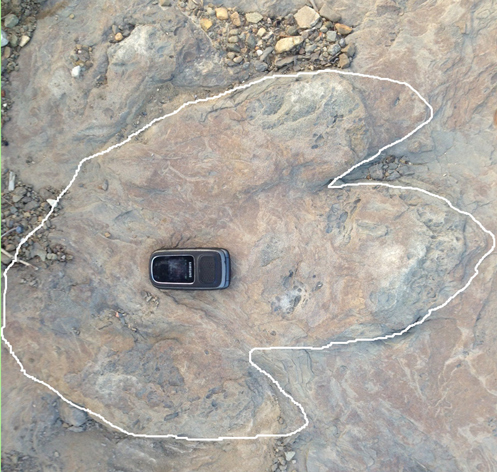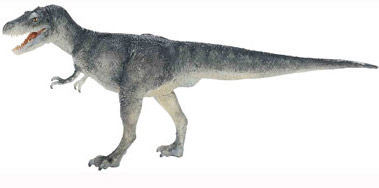Amazing Dinosaur Footprint Discovered In British Columbia
Tyrannosaur Footprint Found in British Columbia
Palaeontologists and ichnologists (scientists who study trace fossils including footprints), are examining the preserved impression of a three-toed footprint made by a large dinosaur during the Late Cretaceous. The single print measures fifty-nine centimetres long and it may have been made by a substantial tyrannosaurid.
Dinosaur Footprint
The footprint was found approximately ten kilometres from the small settlement of Tumbler Ridge. Something like fifteen tyrannosaur footprints have been discovered to date, from locations as far apart as New Mexico, Alberta and Mongolia, but this is the ninth print to have been reported from British Columbia. The print was found by Carina Helm, a geography student at the University of British Columbia who was out working in the area with her father. The track was found on August 20th.
Explaining the circumstances behind the discovery, Carina explained:
“My dad and I were returning in the evening from repairing boardwalks on one of the hiking trails, when I told him I knew of some big exposed rock slabs. We worked out that these were maybe from an age that could feature dinosaur tracks, so we decided to make a detour to have a look.”
The father and daughter team did not have to search for long to find the fossil.
The Three-Toed Dinosaur Footprint
Picture credit: The Helm Family
Commenting on the Dinosaur Footprint Discovery
Looks like mobile phones have lots of uses, for example, the phone in the picture helps to show scale.
Carina added:
“The very first rock I went to, right beside the road, had this huge track-shape on it with three toes. I thought, surely, that is too big to be a footprint? I showed it to my dad and next thing he was on his cell-phone to Rich McCrea telling him about the find.”
The Peace Region Palaeontology Research Centre
Rich McCrea, is one of the palaeontologists at the The Peace Region Palaeontology Research Centre (P.R.P.R.C.), based in Tumbler Ridge. This institute was founded in 2003 to help excavate, preserve and showcase the vertebrate body and trace fossils associated with this part of the Canadian Province. Most of the footprints alleged to have come from large theropods that have been found in this region have come from remote, difficult to access locations. In contrast, this new find was close to a road and is much more accessible.
A Likely Tyrannosaurid Track
Rich and colleague Lisa Buckley were able to confirm that this track was most likely made by a tyrannosaurid. Although the print measures fifty-nine centimetres long, the foot that made it would actually have been bigger, the tip of the longest toe and its claw impression have been eroded away. When asked to speculate the type of tyrannosaur that might have made this track, the P.R.P.R.C. palaeontologists have suggested that this track could have been made by an Albertosaurus.
A Model of an Albertosaurus (Large, Late Cretaceous Tyrannosaur)
Picture credit: Everything Dinosaur
To view the range of prehistoric animals made by Safari Ltd: Safari Ltd Dinosaur Models.
Outlining how the scientists concluded that this was indeed the footprint of a tyrannosaur, Rich McCrea stated:
“It can sometimes be a challenge to identify the maker of a single print, especially one that has been weathered by the elements. Even with the tips of the digits (the claw impressions), eroded away, the footprint found by Carina Helm still possesses characteristics that make it identifiable as the product of a meat-eating (theropod) dinosaur. In addition to the morphological features of the footprint, which bears great similarity to the ones discovered in the Autumn of 2011 and subsequently ascribed to the ichnospecies Bellatoripes fredlundi, the size of the print and the age of the rocks it was found in provide further evidence that the track-maker was a tyrannosauroid.”
A Problem Fossil
This fossil is posing a bit of a problem for the Tumbler Ridge Museum Foundation, the organisation that established the P.R.P.R.C., the fossil is close to a road and therefore it could be vandalised or stolen. Attempts could be made to remove the specimen, but this too, presents problems. The slab of rock containing the print is large and transporting the fossil to Tumbler Ridge would present quite a logistical challenge.
Young Carina is proving to have quite a knack for finding trace fossils, earlier in the Summer, she was part of a team that found two other trackways preserved in much older rocks in the Tumbler Ridge area.



